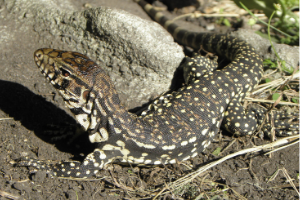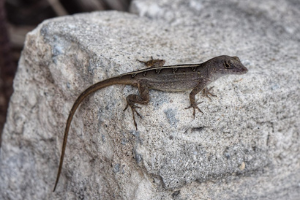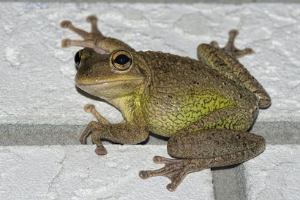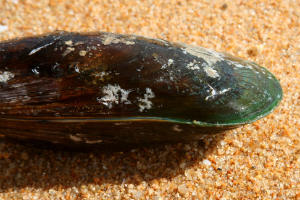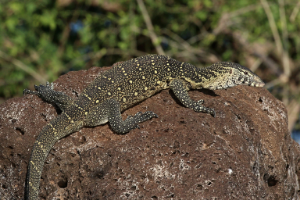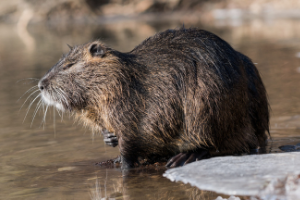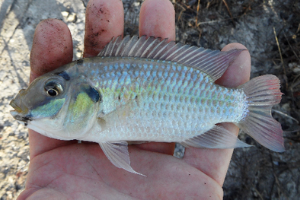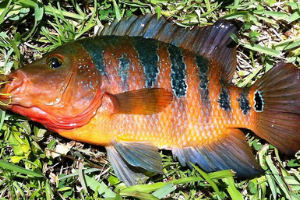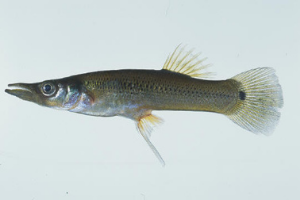| Photo | Species | Home Range | Problem | Management |
|---|---|---|---|---|
| Black-and-White Tegu Salvator merianae | South America | Consume eggs of ground nesters including the gopher tortoise, alligators, and could threatened American crocodiles | Can bite viciously, call FWC. More information |
|
| Brown Anole Cuban Anole Anolis sagrei | Cuba and the Bahamas | Aggressive competitor with native lizards | Collect during cold winter days when they are sluggish, rub 20% benzocaine cream on their back, once numb place in zip lock and freeze. More information |
|
| Burmese Python Python bivittatus | Southeast Asia | Preys on birds, mammals, and reptiles – some which are protected | Dangerous to collect alone, call FWC More information |
|
| Cuban Treefrog Osteopilus septentrionalis | Cuba, Bahamas, Cayman Islands | Consume native species and out compete native treefrogs, clog plumbing, short-circuit electric systems | Use PVC pipe to trap, rub 20% benzocaine cream on their back, place in zip lock and, when numb, freeze. More information |
|
| Feral Hogs Sus scrofa | Brought by the Spanish in 1500s | Compete with native species for food, ground nest raiders, consume young livestock, destroy gardens and wild vegetation | Hunting and trapping are allowed. Check with FWC for rules and regs for different properties. More information |
|
| Green Mussel Perna viridis | Indo-Pacific | Displace native shellfish such as oysters, clock water intakes | Visual inspection of your vessel’s hull, drain bilge before moving vessel to new body of water, can be harvested for consumption in waters where shellfish harvest is allowed, and the harvester has proper license. More information |
|
 | Lionfish Pterois volitans | Indo-Pacific | Consumes at least 70 species of small reef fishes including vermillion snapper | Spearfishing most effective at the moment. More information |
| Nile Monitor Varanus niloticus | Sub-Saharan Africa | Consume eggs of ground nesting native species – including many protected species, also known to take pets | Call FWC. More information |
|
| Nutria Myocastor coypus | South American | Aggressive vegetative eaters and can do damage to a marsh, burrow into dikes and levels making them less stable | Barriers to keep them out, vegetation management to make habitat unattractive, trapping. More information |
|
| Regal Demoiselle Neopomacentrus cyanomos | Indonesia | Unknown at this time. Could reduce native damselfish populations. | No known method of management at this time. If found, contact USGS at https://nas.er.usgs.gov/SightingReport.aspx. More information |
|
| Tiger Shrimp Penaeus monodon | Indo-Pacific | Shown in lab to consume native shrimp, impact in wild is uncertain | No known method of management at this time. More information |
|
| Blackchin Tilapia Sarotherodon Melanotheron | Tropical Africa | Displaces native fish. In one FL spring it was 90% of the fish biomass. Seems to be a reservoir for fungal diseases that can spread. | None known at this time. More information |
|
| Mayan Cichlids Mayaheros uropthalmus Cichlasoma urophthalmus | Central America | Both displacement and predation of native species. | Rod and reel fishing. More information More information More information |
|
| Pike Killifish | Central America | Preys on mosquitofish, other live bearers, and native killifish. Could compete with juvenile snook for shrimp. | No known method More information |
Invasive Animals
You are here:
- Home
- Healthy Oceans and Coasts
- Invasive Species
- Invasive Animals

